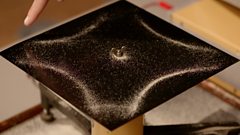
Making Sound
Dr Helen Czerski investigates the science behind the sounds we're familiar with and the sounds that we normally can't hear, from Big Ben to the Stromboli volcano.
Dr Helen Czerski investigates the extraordinary science behind the sounds we're familiar with and the sounds that we normally can't hear.
She begins by exploring the simplest of ideas: what is a sound? At the Palace of Westminster, Helen teams up with scientists from the University of Leicester to carry out state-of-the-art measurements using lasers to reveal how the most famous bell in the world - Big Ben - vibrates to create pressure waves in the air at particular frequencies. This is how Big Ben produces its distinct sound. It's the first time that these laser measurements have been done on Big Ben.
With soprano singer Lesley Garrett CBE, Helen explores the science of the singing voice - revealing in intimate detail its inner workings and how it produces sound. Lesley undergoes a laryngoscopy to show the vocal folds of her larynx. At University College London, Lesley sings I Dreamed a Dream inside an MRI scanner to reveal how her vocal tract acts as a 'resonator', amplifying and shaping the sound from her larynx.
Having explored the world of sounds with which we are familiar, Helen discovers the hidden world of sounds that lie beyond the range of human hearing. At the summit of Stromboli, one of Europe's most active volcanoes, Helen and volcanologist Dr Jeffrey Johnson use a special microphone to record the extraordinary deep tone produced by the volcano as it explodes - a frequency far too low for the human ear to detect. Helen reveals how the volcano produces sound in a similar way to a musical instrument - with the volcano vent acting as a 'sound resonator'.
Finally, at the University of Cambridge's Institute of Astronomy, Helen meets a scientist who has discovered evidence of sound waves in space, created by a giant black hole. These sounds are one million billion times lower than the limit of human hearing and could be the key in figuring out how galaxy clusters, the largest structures in the universe, grow.
Last on
More episodes
Previous
You are at the first episode
Next
Clips
-
![]()
Lesley Garrett performs
Duration: 01:07
-
![]()
Chladni experiment
Duration: 01:58
-
![]()
Lesley Garrett
Duration: 01:58
Music Played
-
![]()
Johann Strauss II
The Beautiful Blue Danube
Performer: Johannes Wildner Conducting The Johann Strauss Orchestra. Orchestra: Vienna Philharmonic. -
![]()
Fritz Reiner, Chicago Symphony Orchestra
On The Beautiful Blue Danube, Op. 314
Credits
| Role | Contributor |
|---|---|
| Presenter | Helen Czerski |
| Participant | Lesley Garrett |
| Producer | David Briggs |
| Director | David Briggs |
| Executive Producer | Jonathan Renouf |
Broadcasts
- Thu 2 Mar 2017 21:00
- Fri 3 Mar 2017 02:45
- Sun 5 Mar 2017 22:50
- Wed 12 Jul 2017 21:00
- Wed 13 Sep 2017 22:00
- Thu 14 Sep 2017 03:00
- Fri 29 Jun 2018 00:30
- Wed 10 Jul 2019 00:00
- Sun 16 May 2021 20:00
- Mon 17 May 2021 01:25
- Mon 27 Jun 2022 00:45
Explore more about the science behind sounds and how we hear, with The Open University
Try the OU's sea shell experiment, to find out why we think we can hear the waves.




